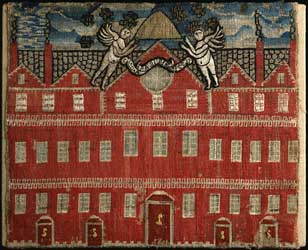Embroidered view of Harvard Hall
To order an image, navigate to the full
display and click "request this image"
on the blue toolbar.
-
Choose an alternate description of this item written for these projects:
- Witness to America's Past
- MHS Collecting History
- MHS 225th Anniversary
- Main description
This early embroidered view of Harvard Hall at Harvard College shows the second building of that name, built in 1676 but destroyed by fire in 1764. Some of the architectural details of that building are confused with nearby Stoughton Hall in this rendition.1 The embroiderer also replaced the cupola with a swarming bee-hive and a variation upon a quotation from Virgil which roughly translates as "They keep out drones from these premises."2
Based upon this quotation which he found used in reference to Harvard among the Leverett family papers, Harvard historian Samuel Eliot Morison in 1933 hypothesized that the piece was worked by Mary Leverett as a gift for her second husband.3 Mary Leverett, the daughter and granddaughter of Harvard presidents, was born in the old parsonage in Cambridge where her father, John Leverett, served as pastor until his election to the Harvard presidency in 1708. She married her cousin Major John Denison of Ipswich in 1719, but he died five years later, and she was remarried in 1728 to another cousin, the Reverend Nathaniel Rogers, also of Ipswich. Both husbands were Harvard graduates. Although only fifty-five at her death, she survived all but three of her two Denison and eight Rogers children.
The piece is worked in the basic half-cross stitch or tent stitch, a decorative thread crossing diagonally the intersecting threads of the linen. The two large putti holding the beehive aloft are done in a technique resembling the stump work popular in the seventeenth century in which forms are padded or raised to produce a three-dimensional effect. The red color of the bricks contrasts richly with the narrow strip of blue, cloud-streaked sky and the dark roof.
1. Hamilton Vaughan Bail. Views of Harvard: A Pictorial Record to 1860. Cambridge, Mass., 1949, p.23.
2. Samuel Eliot Morison. "Needlework Picture Representing a Colonial College Building." Old-Time New England 24 (1933), p.68.
3. Ibid., pp.68-70.
4. John Langdon Sibley and Clifford K. Shipton. Biographical Sketches of Graduates of Harvard University. Cambridge, Mass., and Boston, 1873-1975, 5:527, 6:557.
5. Hope Hanley. Needlepoint in America. New York, 1969, p.24.

